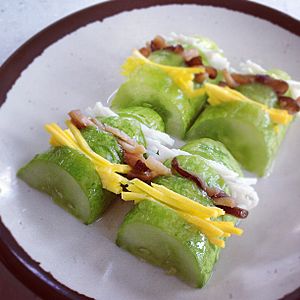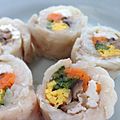Seon (food) facts for kids
| Seon | |

Oiseon, made with cucumber and meat.
|
|
Quick facts for kids Korean name |
|
|---|---|
| Hangul |
선
|
| Hanja | |
| Revised Romanization | Seon |
| McCune–Reischauer | Son |
Seon is a special Korean dish. It's made by steaming vegetables like zucchini, cucumber, eggplant, or Napa cabbage. These vegetables are then stuffed with tasty meat. Seon is a bit like jjim, which is another Korean dish made by steaming meat or seafood. But Seon always uses stuffed vegetables!
There are many kinds of Seon! Some popular ones include:
- Gajiseon (가지선): made with steamed eggplant.
- Gochuseon (고추선): made with steamed chili pepper.
- Donggwaseon (동과선): made with steamed winter melon.
- Museon (무선): made with steamed radish.
- Baechuseon: made with steamed Napa cabbage.
- Dubuseon: made with steamed tofu.
Contents
How to Make Seon
Let's learn how to make hobakseon (zucchini seon) or oiseon (cucumber seon)!
Getting the Vegetables Ready
First, a cucumber or zucchini is cut into pieces. Each piece is about 4 to 5 centimeters long. Then, these pieces are cut into quarters. A little salt is added to the pieces. After a short time, they are gently squeezed to remove extra water.
Making the Stuffing
Next, you need to prepare the stuffing. Beef or chicken is chopped very finely. Onions are also chopped and mixed with the meat. This mixture is then seasoned with different spices.
Cooking the Dish
Now, the prepared cucumber or zucchini pieces are stuffed with the meat mixture. They are carefully placed into a pot. Vegetable broth is poured over the ingredients until they are partly covered. The stuffed vegetables are then boiled or steamed for about 5 to 10 minutes.
Serving Seon
When the dish is ready, it's time to serve! Slices of seogi (석이, a type of mushroom), chili threads, and egg garnish are placed on top. These toppings are called gomyeong (고명) and make the dish look beautiful.
Seon in History
Cookbooks from the past show how Seon has changed over time.
Old Recipes
In a cookbook called Eumsik dimibang, written a long time ago during the Joseon Dynasty, there's a recipe for donggwaseon. This dish was made with dongga (winter melon). The old recipe is quite different from how we make it today.
Back then, thick slices of winter melon were lightly boiled. Then, they were put into a bowl with a mix of ganjang (soy sauce), water, and oil. In another bowl, boiled ganjang was mixed with minced ginger. This was poured over the vegetables. Donggwaseon was served with vinegar on top.
Later Recipes
Another cookbook, Siui jeonseo, from the late 1800s, has a recipe for hobakseon (zucchini seon). This recipe is more like the modern one. A zucchini was hollowed out and filled with different seasonings. Then, it was steamed. A sauce made from vinegar, ganjang, and honey was poured over the cooked dish. It was served with sliced chili pepper, seogi, and jidan (fried eggs). Pine nuts were sprinkled on top.
Modern Meaning
The word "Seon" didn't mean "stuffed vegetables" until the late 1930s. Before that, cookbooks used "Seon" for other dishes. For example, cheongeoseon was steamed and stuffed herring. Yangseon was steamed and stuffed beef intestine. Dalgyalseon was steamed eggs.
Today, when people say "Seon," they are talking about delicious dishes made from stuffed vegetables.
Gallery
-
Baechu-seon (stuffed napa cabbage rolls)
-
Hobak-seon (stuffed Korean zucchini)
See also
 In Spanish: Seon (gastronomía) para niños
In Spanish: Seon (gastronomía) para niños






